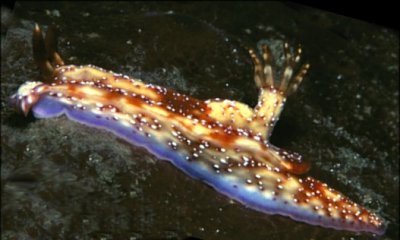
Hypselodoris krakatoa
Gosliner & Johnson, 1999
Order: NUDIBRANCHIA
Suborder: DORIDINA
Superfamily: EUDORIDOIDEA
Family: Chromodorididae
DISTRIBUTION
Subtidal reefs in western Pacific (Taiwan, Hachijo Is - Japan, Philippines, Indonesia, Papua New Guinea).
PHOTO
Kathy's Corner, Milne Bay, Papua New Guinea. Crawling length: 45 mm, Depth: 4 meters. Photo: Mary Jane Adams.
Grows to 55mm long. The colour pattern in complex but consists basically of a pale brown background colour. On the mantle their is a broad dark brown band around the mantle edge and transverse band of the same colour across the midway between the gills and the rhinophores, forming a figure of eight pattern. There is a longitudinal row of bright white spots down the dorsal midline and a submarginal row of spots which runs around the mantle edge. The rhinophore clubs are brown with a white tip and the gills are brownish with white spots up the outer edge of the rachis. The body is relatively high in profile, and the name krakatoa, from an Indonesian island which exploded in a massive volcanic eruption, refers to the high volcanoe-like gill pocket.
Reference:
• Gosliner, T.M. & Johnson, R.F. (1999) Phylogeny of Hypselodoris (Nudibranchia: Chromodorididae) with a review of the monophyletic clade of Indo-Pacific species, including descriptions of twelve new species. Zoological Journal of the Linnean Society, 125: 1-114.
Rudman, W.B., 2000 (August 13) Hypselodoris krakatoa Gosliner & Johnson, 1999. [In] Sea Slug Forum. Australian Museum, Sydney. Available from http://www.seaslugforum.net/find/hypskrak
Related messages
Hypselodoris krakatoa from Lembeh, Indonesia
April 19, 2010
From: Eric Thorén

Found this in the Lembeh Strait and can't figure out what it is. The closest I get from my reference is Hypselodoris krakatoa - but it doesn't fit that well.
Confirm or other suggestion?
Locality: Nudi Falls, Lembeh Strait, 6-8 metres, Indonesia, Celebes Sea, 13 April 2010, on reef. Length: 50 mm. Photographer: Eric Thorén.
Eric Thorén
info@ericthoren.se
Thorén, E., 2010 (Apr 19) Hypselodoris krakatoa from Lembeh, Indonesia. [Message in] Sea Slug Forum. Australian Museum, Sydney. Available from http://www.seaslugforum.net/find/23511Dear Eric,
Yes this is H. krakatoa. This species is only about 10 years old, so we are still learning aspects of its natural history, distribution, and just how variable it is in colour. So its difficult to say whether it 'fits well' until we know more. Messages like yours help to give us a better idea of such 'newish' species
Best wishes,
Bill Rudman
Hypselodoris krakatoa from Solomon Ids
August 28, 2008
From: Barbara Hanchard


Concerning message #21818:
Hi Bill,
Dug back through my photos of Hypselodoris krakatoa which I found back in 2006 on a very memorable dive. Reason I remember it so well is that there were at least 6 different species covering this wreck which had only gone down 4 months prior. For the most part the wreck looked as it was just covered in sediment rather than the beginnings of a fairly established ecosystem of sponges and soft corals. All of the nudibranchs were on the brown patchy "sediment" areas possibly feeding on whitish/opaque looking sponge beneath or on closer inspection on the branch like growth that is covered in sediment.
Locality: Tommy Chan Wreck, Ranadi, 35 meters, Honiara, Solomon Islands, Pacific, 12 January 2006, Wreck. Length: 40mm. Photographer: N. Barbara Hanchard.
Barbara Hanchard
barbara.hanchard@ffa.int
Hanchard, N.B., 2008 (Aug 28) Hypselodoris krakatoa from Solomon Ids. [Message in] Sea Slug Forum. Australian Museum, Sydney. Available from http://www.seaslugforum.net/find/21834
Dear Barbara,
Thanks for looking out these photos. The one in which we can see the whitish sponge is another of those tantalising photos which don't quite answer the question. It could well be a dysideid sponge, on which species of Hypselodoris usually feed, but there is not enough evidence of a fibrous structure present for me to make even a reasonable guess. It could lack such a skeleton or perhaps the fibres are just not visible in the photo. One day we will find some animals all clustered on an easily recognisable sponge colony, but unfortunately, not today.
Best wishes,
Bill Rudman
Re: More Hypselodoris krakatoa from Thailand.
August 20, 2008
From: Vie Panyarachun
Concerning message #21813:
Hi Dr. Rudman,
I'm so sorry but the hard drive where my Hypselodoris krakatoa photos were stored recently "died" and all data were permanently lost. I will try and go back to the site and look for whatever it is the Hypselodoris krakatoa feed on.
Vie
vpanyarachun@hotmail.com
Panyarachun, V., 2008 (Aug 20) Re: More Hypselodoris krakatoa from Thailand.. [Message in] Sea Slug Forum. Australian Museum, Sydney. Available from http://www.seaslugforum.net/find/21818Dear Vie,
Sorry to hear about your hard drive. Any photos showing possible food items are always welcome.
Best wishes,
Bill Rudman
More Hypselodoris krakatoa from Thailand.
August 19, 2008
From: Vie Panyarachun
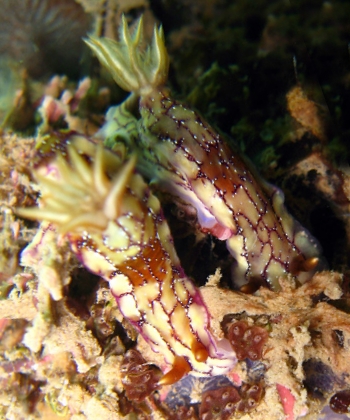
Concerning message #8752:
Some Hypselodoris krakatoa from the northern part of the Gulf of Thailand.
Locality: Off Haad Chao Lao, Chantaburi, 3 msw, Thailand, Gulf of Thailand, 26 January 2008. Length: approx. 30 mm. Photographer: Vie Panyarachun.
Vie
vpanyarachun@hotmail.com
Panyarachun, V., 2008 (Aug 19) More Hypselodoris krakatoa from Thailand.. [Message in] Sea Slug Forum. Australian Museum, Sydney. Available from http://www.seaslugforum.net/find/21813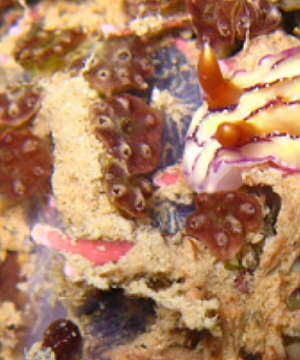
Dear Vie,
Thanks for this record. It looks like these animals are probably feeding, but I can't see any identifiable sponge from your photo. I suspect the bluish patches in the close-up photo are sponge. If by chance you have another photo which shows the area around their heads more clearly, it could be very interesting, as we don't know what sponge this species eats.
Best wishes,
Bill Rudman
Hypselodoris krakatoa from Indonesia
April 2, 2007
From: Jim Anderson
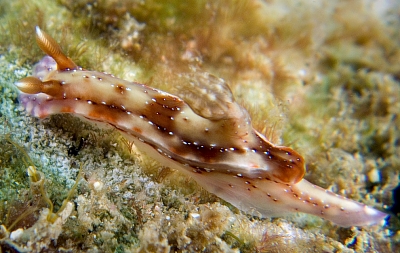
Hello again Bill,
Following a recent trip to Raja Ampat, Indonesia I am sending on some images that I trust will be of interest.
I need your help to ID this animal. I think it might be Hypselodoris maculosa but maybe it's H. krakatoa. It and another couple of the same were not hanging about in the current but heading somewhere.
Locality: Kabui Strait, 8 m, Raja Ampat, Indonesia, Dampier Strait, 5 March 07, current swept channel. Length: 25. Photographer: Jim Anderson.
Jim Anderson
jander4454@gmail.com
Anderson, Jim, 2007 (Apr 2) Hypselodoris krakatoa from Indonesia. [Message in] Sea Slug Forum. Australian Museum, Sydney. Available from http://www.seaslugforum.net/find/19787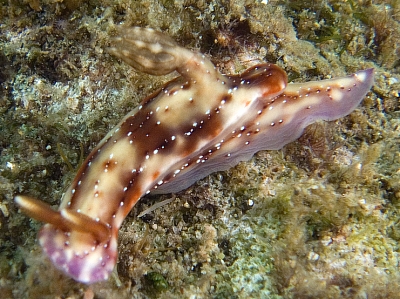
Dear Jim,
The high volcano-like gill pocket, as well as the colour pattern, are a good indication that this is your second choice - Hypselodoris krakatoa. The rakish angle of the gills well illustrates the srong current you mention.
Best wishes,
Bill Rudman
Hypselodoris krakatoa from Hachijo Island
February 15, 2003
From: Rebecca F. Johnson
Hi Bill,
In answer to your comment, I have looked at the animals from Hachijo Island sent to me by Nishina Masayoshi and I think they are H. krakatoa. They certainly are beautiful!! If I have a chance I will sent some SEMs of them.
Thanks,
Rebecca
rjohnson@CalAcademy.Org
Johnson, R.F., 2003 (Feb 15) Hypselodoris krakatoa from Hachijo Island. [Message in] Sea Slug Forum. Australian Museum, Sydney. Available from http://www.seaslugforum.net/find/9223Thanks Rebecca,
Some SEMs of the radula would be very interesting.
Best wishes,
Bill Rudman
Distribution of Hypselodoris krakatoa
February 8, 2003
From: Rebecca Johnson
Hi Bill,
I have been meaning to make a correction in the distribution of Hypselodoris krakatoa for a long time. It was brought to my attention by both Bob Bolland and Liz Kools, the mollusk curatorial assistant here at CAS, shortly after our Hypselodoris paper came out [Gosliner & Johnson, 1999] that we made a mistake in our material examined section for Hypselodoris krakatoa. We had mistakenly listed a specimen of Hypselodoris purpureomaculosa under the H. krakatoa section. So, to make a long story short Hypselodoris krakatoa is not found in Okinawa. Bob Bolland has never seen it or collected it there.
Take care,
Rebecca
rjohnson@CalAcademy.Org
Johnson, R.F., 2003 (Feb 8) Distribution of Hypselodoris krakatoa. [Message in] Sea Slug Forum. Australian Museum, Sydney. Available from http://www.seaslugforum.net/find/9180Thanks Rebecca,
What do you think of the animal from Hachijo Island? It seems to me to fit into the variation found in H. krakatoa. If so, then it is probably only a matter of time before it is found at Okinawa.
Best wishes,
Bill Rudman
Chromodorid from the Andaman Sea
January 2, 2003
From: Danny Van Belle
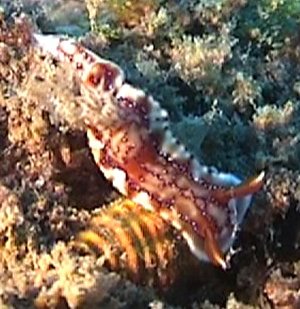
Hi Bill,
I can't find this one anywhere!
Filmed at Boonsung wreck, Taplamu, Thailand, Andaman Sea.
Depth: 20m
Length: 2cm
Best regards
Danny Van Belle
dannyvb@hotmail.com
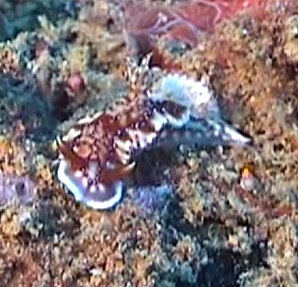
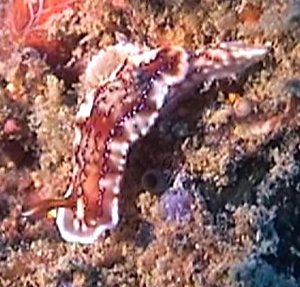
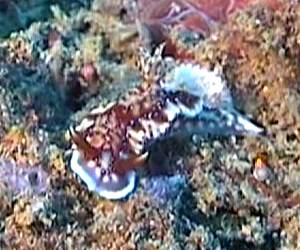
Thanks Danny,
Ths looks to be a colour variety of Hypselodoris krakatoa, so-named because of the 'volcanic' look of the raised gill pocket which you can see in the photo alongside. I think the arrangement of the white spots, confined to dark brown bands, is pretty characteristic of this species. At present I have tentatively identified some more colourful animals from the NW Pacific [Japan, Taiwan] as this species, but until we know more about this recently described species it is difficult to be sure.
Best wishes,
Bill Rudman
Re: Hypselodoris krakatoa? from Taiwan
June 28, 2002
From: Nishina Masayoshi

Dear Bill,
This animal from Taiwan is Hypselodoris krakatoa Gosliner & Johnson, 1999. Recently Rebecca Johnson the animals in these photographs (Hachijo type), to be H. krakatoa. I hope Rebecca Johnson will say something. It seems there is one color pattern of H. krakatoa in the Indonesia - Malaysia region and another pattern further north [Taiwan, Ryukyu Islands Group and Hachijo Island].
I also suspect my animal that I posted before and you identified as Hypselodoris sp. 6 may be H. krakatoa too.
Date: 9 June, 2002
Location: Hachijo Island Japan
Depth: 6m
Length: 30mm
It's common at Hachijo Island.
Best Regards,
Nishina Masayoshi
nishina@wips.co.jp


Thanks Nishina,
I agree that then animal I called Hypselodoris sp. 6 is the same as your animal. In your earlier specimen there was no sign of the white spots which seem to be the link between the Japanese-Taiwan colour form and the much browner Malaysia-Indonesia colour form. Rie Nakano's animals, which I previously doubted were H. krakatoa, show the white spots along the purple longitudinal lines, and are clearly the same 'colour form'.
Best wishes,
Bill Rudman
Hypselodoris krakatoa? from Taiwan
June 24, 2002
From: Todd Garthwaite
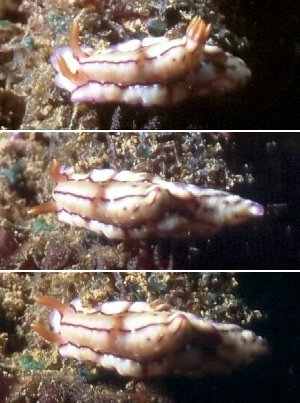
Hi Bill,
Here are three shots of what I believe to be Hypselodoris emma, however, I'm not a hundred percent sure. I would certainly appreciate it if you could help me identify this nudibranch. I came across this specimen in a very shallow, rocky area with sponges, and hard coral.
Site: "Jin-Sha Wan" (["Golden Sand Bay"], N.E. Coast, Taipei County, Taiwan)
Date: 08 June 2002
Time: 09:33am
Depth: 2.3 meters
Temp: 25 degrees C.
Size: Approx. 25 mm
Stay golden.
Best wishes always, (and many thanks),
Todd Garthwaite
(Taipei, Taiwan)
typhoontoddy@yahoo.com
Garthwaite, T., 2002 (Jun 24) Hypselodoris krakatoa? from Taiwan. [Message in] Sea Slug Forum. Australian Museum, Sydney. Available from http://www.seaslugforum.net/find/7246Dear Todd,
I would hazard a guess that this is a colour form of Hypselodoris krakatoa. It doesn't seem to have such 'volcanic' gills as earlier photos on the Forum, but the white spots along the outer longitudinal lines seem to suggest a link. But let's wait for some comments from others who may have other ideas.
Best wishes,
Bill Rudman
Hypselodoris krakatoa in West Malaysia
June 19, 2002
From: John Yap
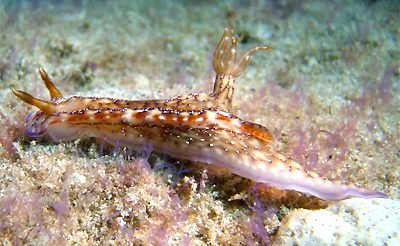
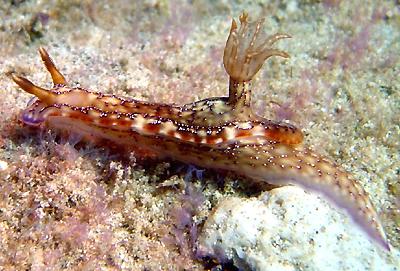
Hi Bill,
I am very excited to record the occurrence of the H. krakatoa in West Malaysia on 7th June 2002 5:29pm . I found this gorgeous animal at about 5 metres of waters under a jetty at Pulau Aur (70km east off West Malaysia). It's was about 75mm in length and crawling on sandy bottom with some algae-like growth.
Cheers!
John Yap
johnyap@tp.edu.sg
Yap, J., 2002 (Jun 19) Hypselodoris krakatoa in West Malaysia. [Message in] Sea Slug Forum. Australian Museum, Sydney. Available from http://www.seaslugforum.net/find/7263Thanks John,
The upright gill pocket in your photos clearly shows why this species was named after the volcano Krakatoa.
Cheers,
Bill Rudman
Re: Hypselodoris krakatoa from Philippines
May 28, 2002
From: Jeff Rosenfeld
Bill,
The animal in the photo was a rather small specimen, in the neighborhood of 7mm I'd estimate.
Jeff
jhrosenfeld@seattleschools.org
Rosenfeld, J., 2002 (May 28) Re: Hypselodoris krakatoa from Philippines. [Message in] Sea Slug Forum. Australian Museum, Sydney. Available from http://www.seaslugforum.net/find/7074Thanks Jeff,
Bill Rudman
Hypselodoris krakatoa from Philippines
May 26, 2002
From: Jeff Rosenfeld

Bill,
Here is a shot of a juvenile Hypselodoris krakatoa taken in Anilao, Luzon Island, Philippines in April, 2002. It's interesting to note how dramatically the color of this species changes between the juvenile and
adult forms.
Jeff
jhrosenfeld@seattleschools.org
Rosenfeld, J., 2002 (May 26) Hypselodoris krakatoa from Philippines. [Message in] Sea Slug Forum. Australian Museum, Sydney. Available from http://www.seaslugforum.net/find/7046Thanks Jeff,
A very interesting piece of information. Can you give us some indication of size? It would also be nice to see some intermediate stages.
Best wishes,
Bill Rudman
Hypselodoris from Hachijo
April 9, 2002
From: Rie Nakano
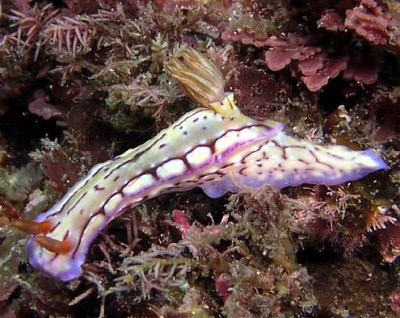
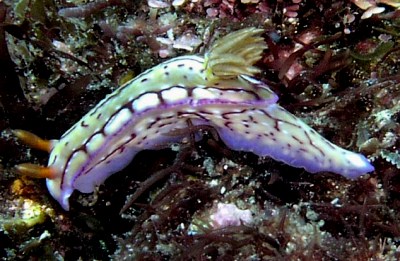
Dear Dr.Rudman,
I found this Hypselodoris at the top of the rocky reef of Hachijo Island, Izu, Japan, in 27th, September, 2001. At first, I thought this animal was Hypselodoris krakatoa, but the background color of this animal is pale beige, mantle edge color is light purple, has not bright white spots. The gills are without white spots up the outer edge of the rachis.
Is this H.krakatoa? Or another spacies? Mr. Masayoshi Nishina says this one and his Hypselodoris sp. are the same species.
Depth:15m
Length:30mm
Water temperature:24.6 degrees
Frequency: common in Hachijo
Sincerely,
Rie Nakano
rie@divers.ne.jp
Nakano, R., 2002 (Apr 9) Hypselodoris from Hachijo. [Message in] Sea Slug Forum. Australian Museum, Sydney. Available from http://www.seaslugforum.net/find/5501Dear Rie,
I would agree that this is the same as Nishina's photo. I don't think it is a colour form of H. krakatoa. Temporarily I will call it Hypselodoris sp. 6.
Best wishes,
Bill Rudman.
Hypselodoris sp? from Japan
October 3, 2001
From: Nishina Masayoshi


Dear Dr.Rudman,
Hypselodoris sp (I think) is not common in Hachijo.
Data: Sokodo, Hachijo Island, Japan
Depth: 7m
Size: 30mm
Date: 1 July, 2001
Best Regards,
Nishina Masayoshi
nishina@hpe15.wips.co.jp
Nishina, M., 2001 (Oct 3) Hypselodoris sp? from Japan. [Message in] Sea Slug Forum. Australian Museum, Sydney. Available from http://www.seaslugforum.net/find/4944Dear Nishina,
I agree that this is probably a species of Hypselodoris but I don't recognise the species.
Best wishes,
Bill Rudman.
Hypselodoris krakatoa from Papua New Guinea
August 17, 2000
From: Mary Jane Adams

Hi Bill,
This is one of a pair of slugs I found crawling over a silty sand slope in November, 1996. It has since been named Hypselodoris krakatoa for it's volcano shaped gills (Gosliner & Johnson, 1999). It was ID'ed for me by Dave Behrens.
Divesite: Kathy's Corner, Milne Bay, Papua New Guinea.
Crawling length: 45 mm
Depth: 4 meters
There is some information about this species on the Slugsite: http://siolibrary.ucsd.edu/slugsite/nudwk213.htm.
Best regards,
Mary Jane
mjadams@earthlink.net
Adams, M.J., 2000 (Aug 17) Hypselodoris krakatoa from Papua New Guinea. [Message in] Sea Slug Forum. Australian Museum, Sydney. Available from http://www.seaslugforum.net/find/2862Thanks Mary Jane,
Its nice to have a lateral view to complement the dorsal photo in Gosliner & Johnson's article. Your photo certainly shows the volcano-like gill pocket.
Best wishes,
Bill Rudman.
